Fang Echo Wang
Translating Trauma Through Play: A Rendering of Adversity Into Playful Tactile Art
Summary
The work described in this dissertation is the result of “play experiments” focused on exploring the differing materiality of mediums in relation to the concepts of touch and tactility, and how they connect with past trauma. I primarily used auto-ethnography as a research method, basing the work on my past traumatic experiences. Translating these experiences into work that was simultaneously dark and playful was a way to digest the incidents; not a healing process. For me, trauma can never be healed, but one can attempt to understand and digest it in some way.
The research resulted in six distinct works, each exploring materiality, tactility and touch to some extent. To be connected with and having the desire to explore the tactility of the work is to encourage and invite the inner child back to a stage of free exploration: before there was any shame, guilt, rules or regulations. I hope that by encouraging the audience to interact with the tactility of the work, it can challenge and blur the boundaries between artist and audience. When presented within a glass showcase in sanitised, inaccessible gallery environments, artwork can be castrated of its sense of vitality as a tactile, physical object. To use tactility is to encourage my audience to reconnect with the tactile world around us, and make use of a sense that is often taken for granted.
Additional info
Following content contains explicit personal experiences that may cause discomfort to some readers.
Trigger warning: Needle, blood, sexual assault, domestic violence, racism
Exorcism
My artistic interest in tactility and touch as a way of creating work has been present for many years, but the experience I had creating Exorcism in November 2021 as part of my experimentation with materials and methods was formative. Exorcism describes a group of fourteen paintings I made with a syringe I had used to extract pus from a cyst growing underneath my skin. Using my amateur understanding of medical practice and equipment, and inspired by vague memories of similar procedures I had experienced as a child, I removed and expelled a ‘foreign’, unwanted presence in my body. The feeling of the needle was different from what I had expected: there was less pain; the penetration wI instinctively began to paint using the syringe: drawing the watercolour based paint into it and releasing it directly onto sheets of 100 x 50 cm rice paper.I was seeking to capture my experience of two contrasting states:the toxic (which felt natural, embodied, warm) and the sterile (which felt artificial, exterior to the body, cold). The skin and flesh are the only means by which we can haptically connect with what is around us, and this process reminded me of how I often take my body for granted. I couldn’t have experienced the infection without the existence of my skin, without inhabiting a fleshy body; and my skin would not have experienced the artificial, medicalised sensation of coldness without the needle.
The technical aspect of these pieces is reminiscent of the work of Jackson Pollock. His usage of non-traditional instruments, including syringes, as well as his painting technique of using the whole body expressively, helped me to achieve the simultaneously chaotic and ordered result I desired. Despite that, those works are not as abstract as they may seem. I wanted to achieve a result that was reflective of a very specific subject. My fourteen resultant paintings were both chaotic and precise in the traces of the watercolour paint on the rice paper. These works imitate both the panic induced confusion and tactile clarity of an unwanted invasion of the body, our most personal property. Using the syringe afforded me a surprising amount of control, although it was a very different experience from using a brush. The motions of my body and arm made a direct impact on the paper, even down to how much pressure I applied to the plunger. The harder and faster I pushed, the straighter and more direct the line, whereas gently squeezing it resulted in drips and blotches. The bursts and streaks of bright, garish colour on a stark, white and fragile background emulate the sharp, sensory flashes of pain we experience which function to signal danger to our conscious mind, and immediate threat to our delicate body. As well as this, the process of filling the syringe was satisfying, watching each colour I chose fill up the inside like the biological and chemical fluids it was intended for. The initial colours were actually mixed with my blood: most obviously in the reds, and getting more diluted as I went along, eventually not being visually noticeable at all despite still actually being present. This reflects the presence of a traumatic experience itself: initially sudden and all encompassing, and eventually fading into the background noise of life. The yellows and greens are vividly biological, bringing to mind diseased organs and bodily liquids, and sit alongside the blues and greys of inorganic technology.
Deliberate self-harm is now acknowledged as being a separate phenomenon to suicide, instead being “an active coping mechanism used to avoid suicide.” It is often employed as a method to take back agency and control, especially when experiencing unwanted intrusions to the mind or the body. Like creating art, it can be a way of processing and understanding trauma, and of refocusing negative and destructive energy. Many of the pieces I have created recently make use of found and recycled objects, and reusing that which is sourced from one’s own body is an extremely direct way of achieving a visceral connection with the work. Artists are driven by an internal compulsion to create, and I believe that this urge, to digest and process feelings, rather than to attempt directly therapeutic action, reflects my own experiences most accurately. I needed to expel the paint onto the paper just as intensely as I needed to expel the poison from my body: not as a means to an end, but as a process of filtering and understanding experience.














The Little Monsters
I don’t have a sense of grounding in this world. The experience of constantly migrating from one place to another, with legs always on the move, has left me with a sense of rootlessness. The struggle of standing on your own feet, the trial and error; these are important parts of finding your own identity, separate from that of your family and background. I took inspiration from the experience of growing plants hydroponically for the past three years I have been in London. Despite not being traditionally water based, these plants grow strong and functional, but swirling and portable roots with which they extract nutrients from the unstable environment they are in.
Serendipity is another common theme running through much of my work; allowing things to fall into place naturally appears to be a form of collaboration with materials, as they communicate with me their desired form. The Little Monsters were made with recycled paper and wire. The malleable and unstable nature of the glue and paper mix meant that they struggled to stand in one position to begin with, but slowly gained stability in their own ways as they dried out over a week. I had to care for them frequently, as they might finally stand for a moment, only to fall completely on their ass a few hours later. I felt like a proud parent, watching them finally stand alone and independently. I see all my artworks as my children in some way, but felt a more affectionate and sympathetic connection with these creatures than I have with much of what I have done previously. Their forms may look strange to some observers, but also cute: mixing the disturbing and weird with the cute and humorous is common in many of my works, and helps them to become more palatable to a wider range of audiences.
Despite the Little Monsters all being similar and unmoving, their colours and poses serve to create an individual personality for each one, some brave and some timid. I chose bright, primary colours as an intentional link to childhood toys and memories. The work also has a connection to another common early life developmental phenomenon: imaginary friends. These often function to help establish socialisation and emotional regulation in children. I I developed my own imaginary friend after learning that I very nearly avoided being aborted at the age of 5, and that my mother instead aborted another child who would have been my one year younger brother. I was filled with guilt and a sense of being unwanted by the world as a child, and this manifested itself as my companion, who I then imagined a tragic end for at the age of 10. The eyes of the monsters symbolise insight and spiritual awareness. As well as this, it shows that they are searching. In the story I created for them, they are searching for their mother. To help them, I took them on a journey to find her: a tree by the lake in Battersea Park. Like them, she looks unbalanced and like she could fall at any moment, but still manages to stand firm in her own way.

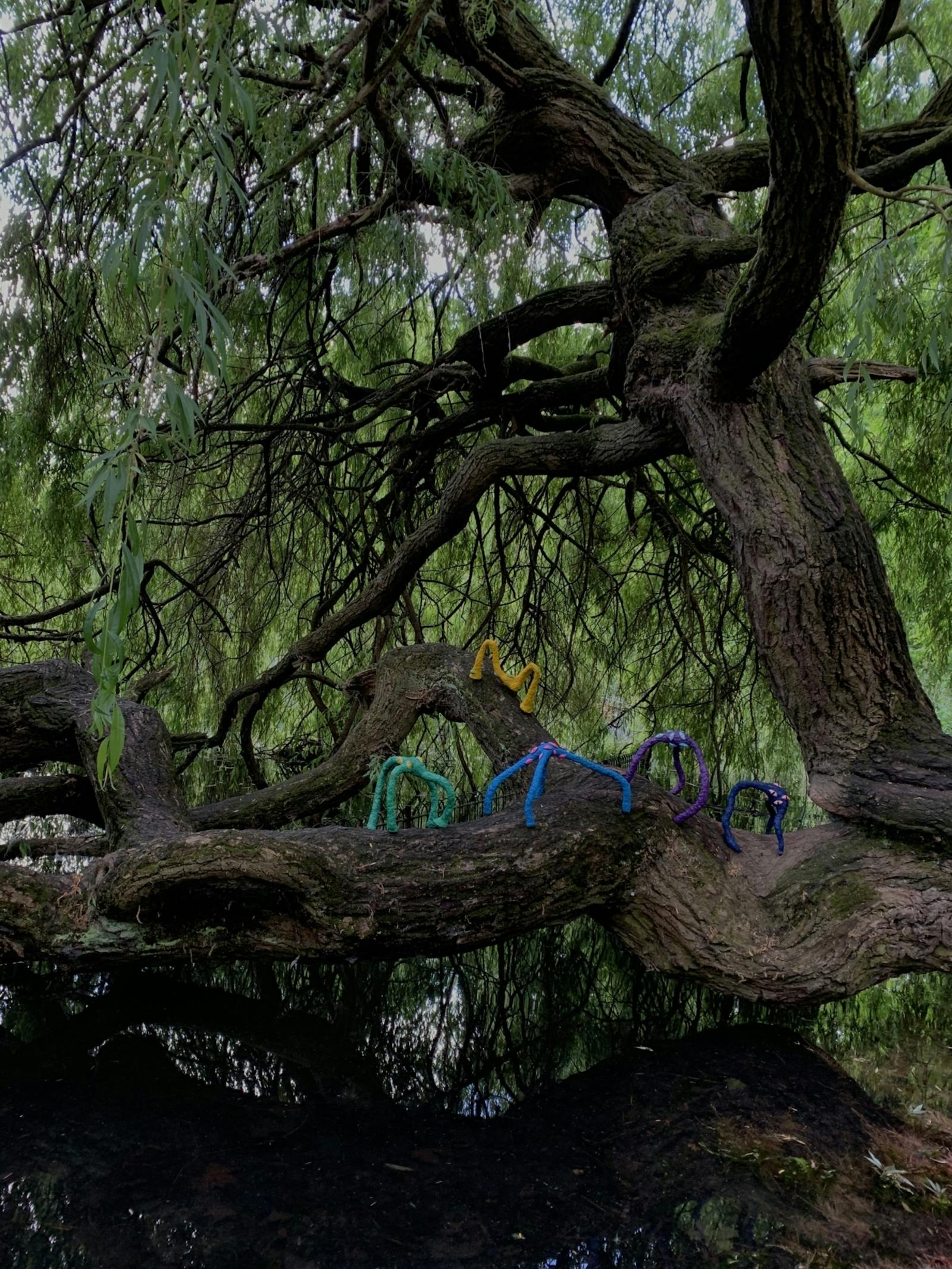
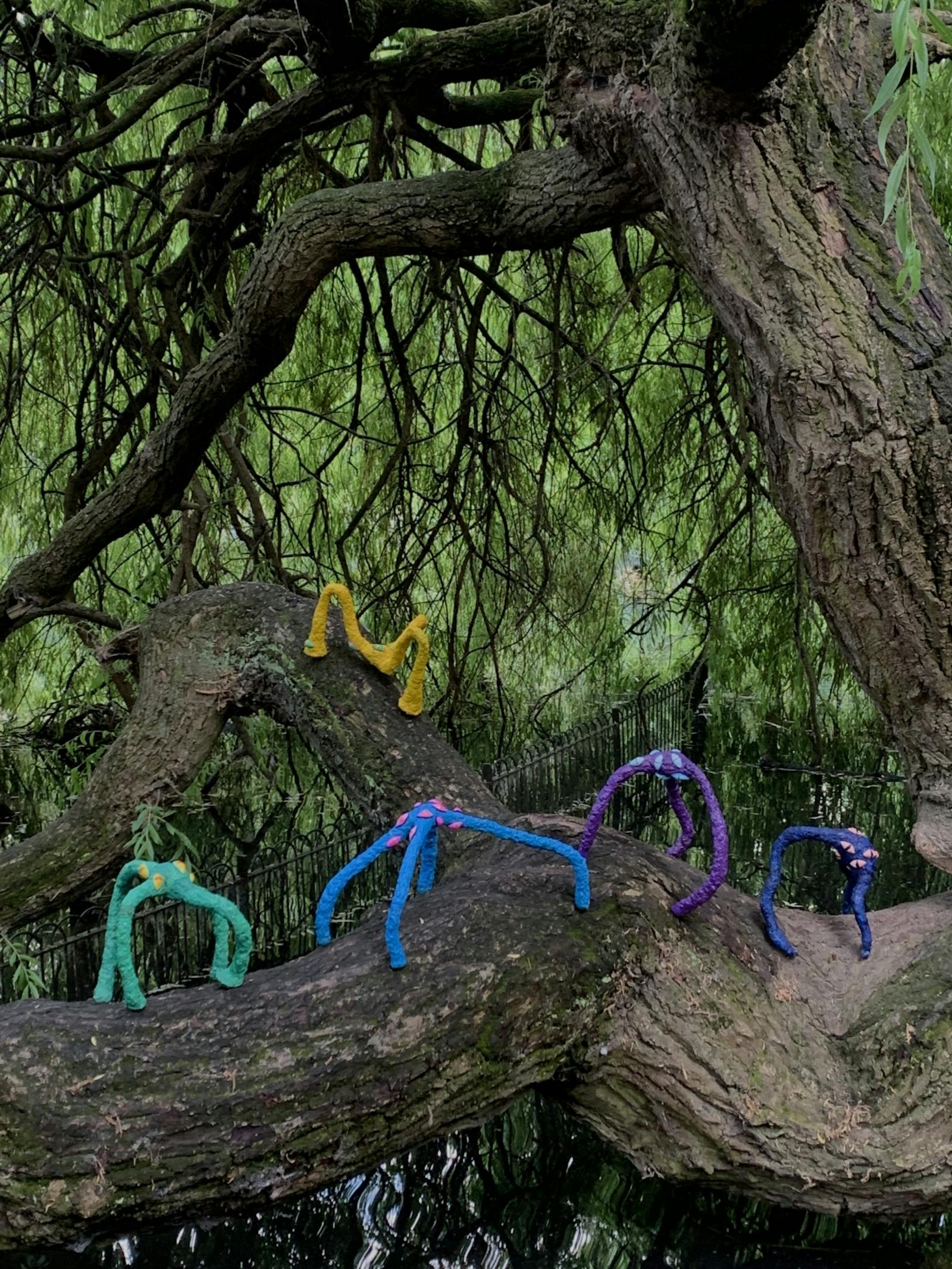

Play With Me
Playing, as such an important part of development, is of great interest to me as an artist. Whether or not this is an attempt to recreate an idealised childhood that was never real, thus creating a world where I can play forever, the interactivity and tactility inherent in my work is one of its most distinct features. It is a way to communicate feelings without words and without the boundaries that are often imposed by society in other contexts.
Touch’s simultaneous existence as both an objective and subjective sense, as well as its lack of commodification (compared, for example, to sight), makes it a bountiful source of inspiration and creativity. As well as this, inviting the audience to physically play with my artwork and interpret it in whichever way they see fit has long been a major part of my work. Play With Me is heavily inspired by this desire and concept, as well as exploring the tension and fluid relationship between nature and humankind.
Theories and concepts of audience interactivity have also been explored by artists such as Ernesto Neto, whose works invite audiences to experience them on a variety of sensory levels, blurring the boundaries between the piece and the person experiencing it. The tactility and disconnect from reality inherent in the spaces he creates are something I also wish to achieve with much of my work, and Play With Me is a typical example. My wish is for audiences to be so immersed in the experience of playing that they forget about where they are and why they are there, instead tapping into a sense of inner wonder and joy. Audiences are so important to fulfilling the work’s purpose: as Barthes states in The Death of the Author, “a text's unity lies not in its origin but in its destination”. My aim for these interactive pieces is for my status as their creator to be irrelevant. Instead, the audience takes on the role of artist through their own interpretation.
During a field trip to Dungeness in March 2022, I found various mosses growing out of cracks in the cement. Humans have been trying to conquer nature for millennia, but nevertheless, nature prevails and grows back. Mosses are some of the most hardy and resilient life forms on our planet, able to withstand and grow in even the harshest of conditions. Moss can survive in areas where other plants simply cannot, including both natural and man made surfaces. This ability to function and survive beyond almost any situation and environment is a clear parallel to the abilities of the human body and mind to heal from trauma. Moss may take a long time to break through concrete, but it can eventually grow over and around it until it is no longer visible. This is a testament to nature’s sheer determination and refusal to allow external forces to shape it for too long. I can find endless inspiration from plants, and how they always seem to manage to bend towards the light.
I emulated the growth of moss on man made objects by creating concrete sculptures, and fusing them with artificial “moss” rugs I made with a tufting gun and frame. As well as symbolising how nature prevails over human intervention, it is also a playful, interactive piece, allowing the audience to feel and experience the varied textures and surfaces without disrupting the growth of real, living moss. These pieces are informed by my ideas about the importance of respect for the natural world, and retaining a healthy and sustainable balance for nature and humankind alike. The focus on audience interactivity and inclusion is also hugely important to me, reflecting my beliefs about the significance of accessibility in art. Engaging audiences to play with and be close to artworks can only foster a stronger relationship between often too distant worlds of art and everyday life.
This work builds upon and expands my previous experiments with tactile and interactive art pieces, with a clear and intentional link to “play therapy”. The work was displayed as if it were in a sand pit, a therapeutic method often used for victims of trauma and PTSD. These forms of therapy have been shown to have a positive effect on adult and child sufferers of trauma alike. Simulating past experiences of childhood play by encouraging the audience to interact with the artwork, feel the textures, and place them in any way they see fit can draw out an unconscious reaction, acting with no preconceptions or guidelines. Jung states, “Often the hands know how to solve a riddle with which the intellect has suffered in vain”, and this can be especially true when attempting to work through or express what a victim does not feel comfortable verbalising or directly confronting. I hope that Play With Me can, through the medium of art, also open up a tactile, non verbal communication between myself and my audience. This artwork is incomplete without audience participation, and the act of this reverses the established dynamic between artist and audience, placing myself in the viewer role, and whoever wishes to play with it as the artist.

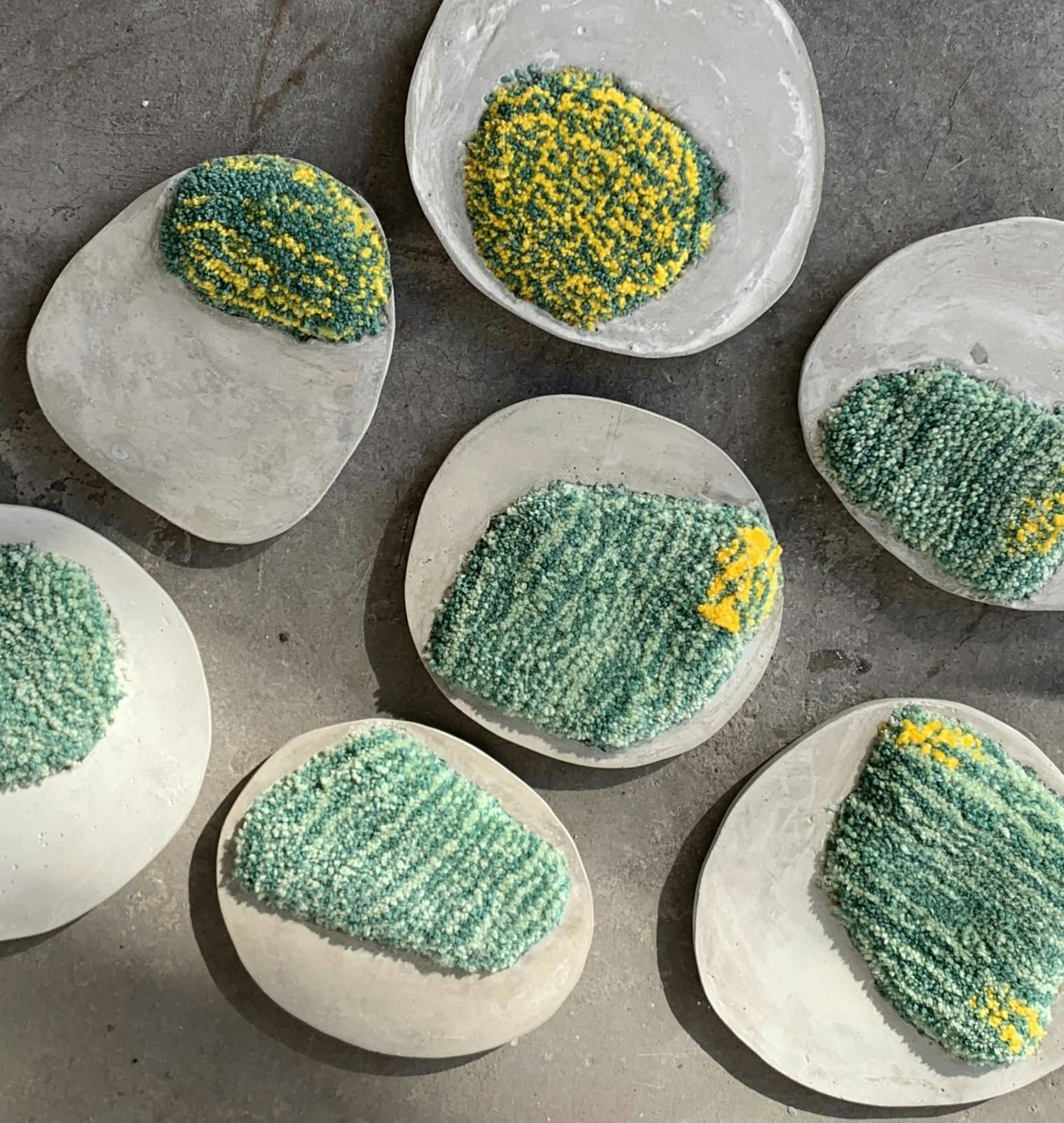
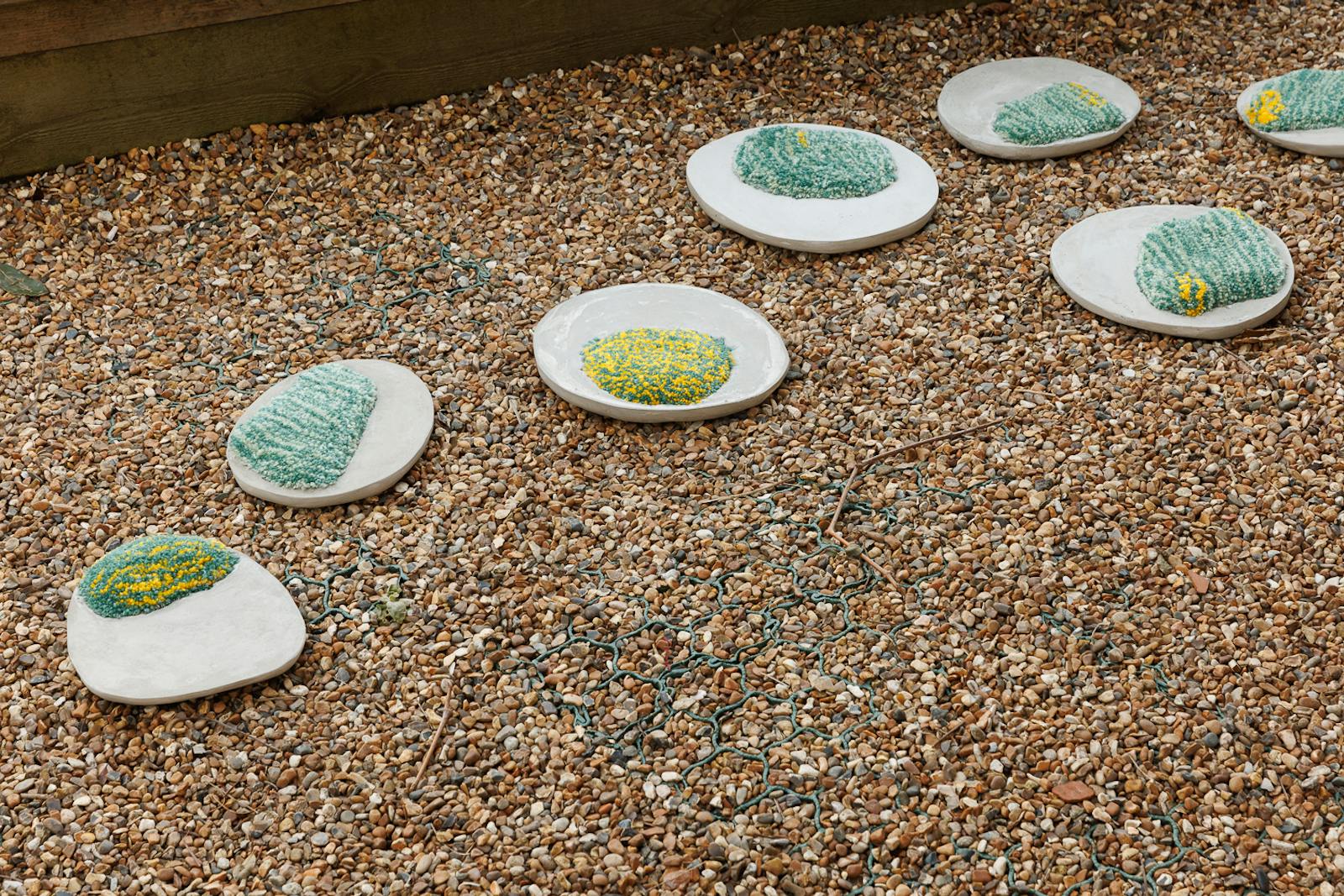
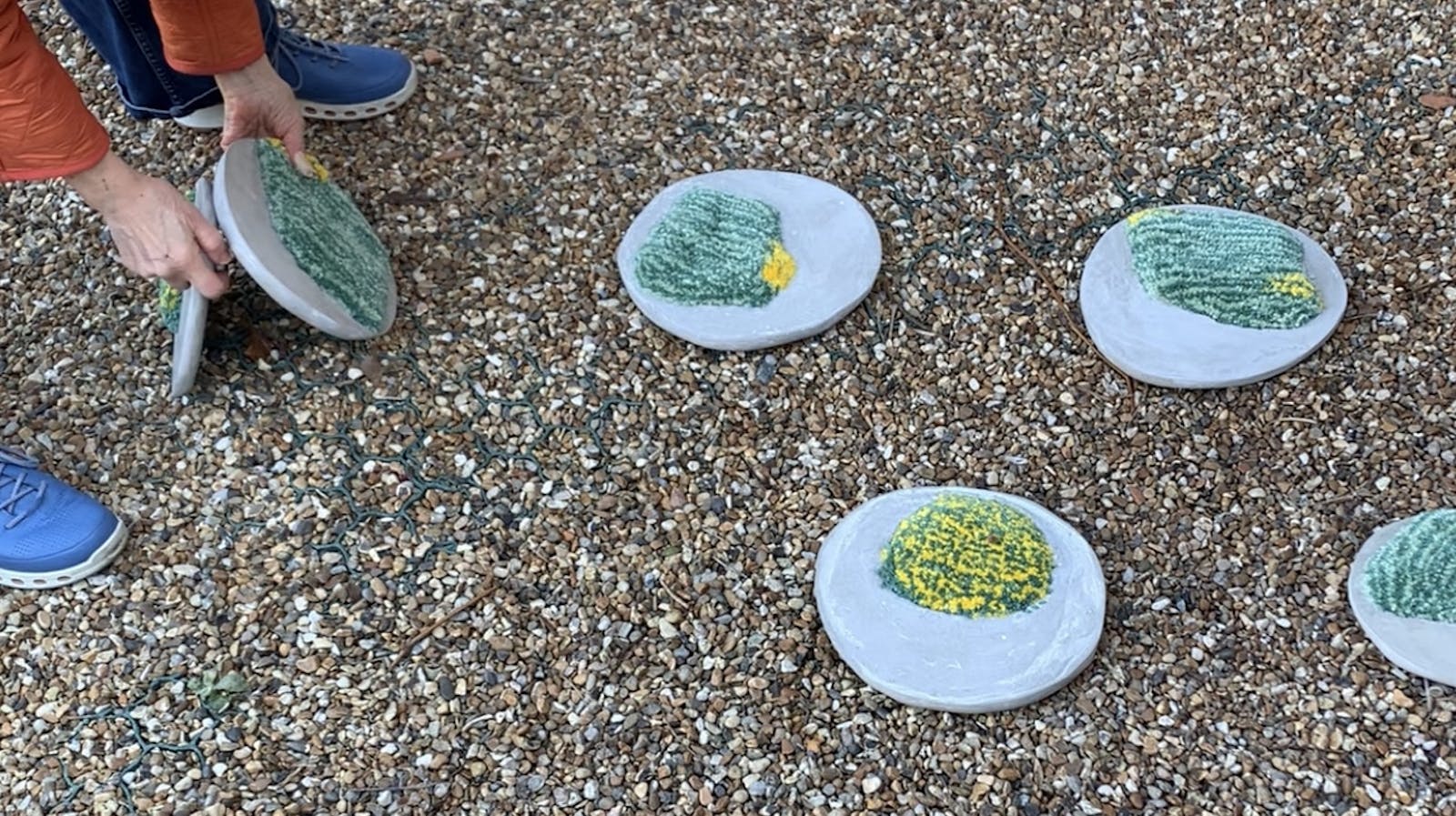
The Unacceptable Body
This group of works is inspired by a reclamation of a product (waxing beads for body hair) designed to sterilise and objectify the female body to suit the male gaze. With this wax, I instead created works which reflect the chaotic and messy reality of living in a human body. I was recently diagnosed with polycystic ovary syndrome, a medical condition which can affect and disrupt female hormone levels. This has resulted in a high level of testosterone and a reduced level of oestrogen in my body, and I have been put on a treatment plan including dietary changes and taking hormonal pills. This has caused a lot of confusion and uncertainty around my gender identity, as well as a great deal of physical and emotional discomfort.
For many years I have seen myself as gender fluid, as I never particularly identified as a woman. In the past, I had often been mocked and humiliated for traits that I now know symptoms of PCOS, such as increased body hair. There have been some studies on the connection between PCOS and gender dysphoria, but as far as I can tell they are inconclusive. Because of this, all I can go on is my own personal experience with this issue, and how it has combined with social constructs of gender and my own internalised self image to affect the way I identify. All of this gave me the idea to use waxing beads for something expressive, rather than as a tool to shape my body to fit notions of conventional femininity.
The hormonal shift caused by starting the course of pills hit very hard. Almost immediately, I experienced side effects including mood swings, body pain and fatigue. Channelling these feelings resulted in work that symbolises the chaos and uncertainty inherent in a sudden hormonal change. The uncompromising and intense portrayals by Frida Kahlo of her often extremely uncomfortable and unsettling bodily ailments are incredibly important for an artist trying to make sense of similar experiences. Her refusal to sanitise her reality ensures that her work is a continued inspiration, especially to those pushing the boundaries of gender stereotypes. I contrasted bright, gendered colours with more earthy and neutral tones, representing the dichotomy between socially constructed gender stereotypes and the true, physical and unsterilised bodily human experience.
At the same time, I wanted to avoid the previously established ideas in this field of creating works representing body parts directly as a statement on objectification. I instead wanted to focus on the turmoil and disconnect with my identity caused by both the medical treatment and trying to understand my place in a restrictive and reductive society. This led me to the use of gravity as both a collaborator and boundary. After pouring the wax, but before it set, I tilted the base at different angles to allow it to flow and spread in various directions. This symbolises the pushing of boundaries, testing the limits of the framework we find ourselves in. Boundaries are pushed gradually, as is necessary for our survival; but also as much as possible, as is necessary for our progress. Women who challenged these boundaries in history have been labelled witches, burned and misunderstood, but subverting the patriarchal and capitalist world we live in is hugely important for the progression of fairness in society as a whole.
















Disembodied Hands
Unwanted touching is an experience many of us have in common, and the victims are very often children, women, and visibly LGBTQ+ members of the community. These assaults, although done out of a desire for sexual gratification, are also about control and dehumanisation of the victim. As well as that they are almost always perpetrated against those who are physically weaker, the fact that they often happen in crowded public places where those responsible cannot be clearly identified shows just how cowardly and pathetic these people are. The response that comes from an experience like this is an extremely complex one. In a patriarchal society where objectification and commodification of the female body is normalised, confusion, fear and self blaming is very common. These feelings are often followed by anger: not only at the perpetrator, but at the self, for being in a position or situation where this could happen in the first place. These cause long lasting guilt and shame, which can often not be rationalised. Depictions and acknowledgements of sexual violence were often romanticised and glamourised in pre-contemporary art.
Despite the common line of thinking that the victim and their behaviour or clothing are somehow responsible for the assault, the range of clothing and situations presented in What Were You Wearing? (2019) shows that in fact this has no effect whatsoever, and that anybody could be a victim. My own experience with trauma is that it never truly goes away. It is always waiting somewhere in the background of the mind to make its reappearance, and this can be triggered by even the most seemingly unrelated things. It grasps and reaches around the corners of your memory, blindly trying to reattach itself and worm its way back into your life. Like these hands, suddenly appearing from the doorway, seeking something to hold onto to make themselves real.
However, these hands are powerless, feeble and flaccid unless mounted for display. When they are not, they are just grasping desperately and mindlessly. In making these simplified, abstract and colourful hands, I have objectified the tools of objectification, reducing them to a powerless and laughably non threatening piece of art. I searched for used and unwanted items of clothing at charity shops and car boot sales, and ended up with a large stock of potential materials to recycle. When I had selected the materials, I hand cut them, sewed them together, and filled them with toy stuffing and wire so that they would remain in specific poses. These are materials which have been touched and used many times, just like the hands that they have been turned into.




Mother
The relationship between a child and their mother is, in many cases, the basis upon which all future relationships are built. Both physical comfort and the eventual separation of the self from the other are vitally important for healthy development, and the lack of one or both can lead to a lifetime of pain and confusion. Initially, many child psychologists believed that the nature of a child’s attachment to their mother was based on food. Despite its support by some prominent figures, this theory of “cupboard love” was challenged by others, including American psychologist Harry Harlow. Beginning in 1958, Harlow conducted a series of experiments in order to better understand attachment theory. The basis of these experiments was to separate baby rhesus monkeys from their mothers, and instead give them a choice of two surrogate figures: one which was made from cloth and physically soft, and one that was made of wire. Some monkeys were only able to receive food from the cloth mother, and the rest only from the wire mother. He found that all of the monkeys chose to spend the majority of their time with the cloth mother, even when it could not provide food, and that they would only visit the wire mother when hungry.
Tactile, physical comfort is therefore hugely important in early life development. For me, this artificial mother serves a similar purpose as Harlow’s cloth mother, having been separated from my family for three years. Sarah Lucas, although having a strong sense of humour in common with my own work, also has many noteworthy differences. Pieces such as Pauline Bunny, although satirising the male gaze, also stereotype and attack feminine forms. Whether intentionally or not, this to me represents an oversimplified version of the female form, falling into the “Madonna-whore complex” that modern feminism is attempting to gain distance from. Instead, I wanted to create a more well rounded and complex, but also more abstract portrayal of a woman I know well, but have always wanted to know more.
I intentionally chose colours and features that were soothing and comforting: the bright, pastel palette is reminiscent of a child’s playroom, while the golden “halo” is an instantly recognisable signal of virtue and benevolence in many cultures. The presence of this halo also reflects how I thought of my own mother, as some distant and inscrutable figure, almost a goddess to be worshipped. The large eyes serve to gaze upon me in divine judgement, looking both ahead and behind like Janus. Along with this, the three legs allow her to perform her duties and tasks: always busy, always moving and travelling. As a whole, it is very soft, and its shape and size makes it easily huggable. After making it, I hung it in a doorway in my house, and felt as if it were watching over me.
The way that Louise Bourgeois made use of domestic and everyday materials to create her works challenged the previously established definitions of sculpture and further democratised the process. Her works are intimate and subtle, although visually striking, and the tactility of the familiar and used materials helps form a strong connection with the audience. As well as this, her usage of family relationships and unspoken dynamics thematically had a strong impact on this work in particular. Her recurring imagery of missing and lone body parts also shows that there is a sense of aesthetic appeal in the incomplete, influencing my own decision to use limited and exaggerated body parts for my own sculpture.
To the child, an understanding of the boundaries between the self and other people both physically and emotionally is extremely crucial. The first separation of this kind a child will experience is often through play. This can be a safe place to explore different concepts while learning how to function independently. Eventually, a child will be able to play both independently and collaboratively, instead of using the mother as a safe base. Early independence, often achieved through the use of a “transitional object”, will allow a child to develop healthily, and this object is often the first item that reflects ownership of something external, rather than being a part of the self. This figure serves as a “transitional object” for me as an adult. Since moving to London, I feel a greater freedom and independence from my family than ever before, but still love and miss them deeply. This piece can help me process these feelings, as I learn to truly stand alone for the first time.





